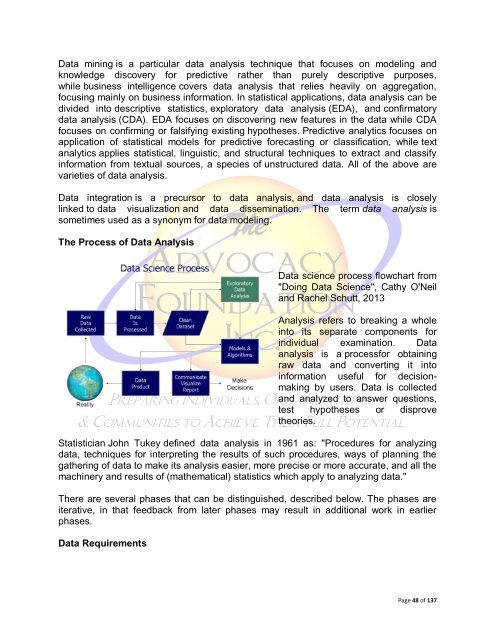Community Needs Assessment Process
Community Needs Assessment Process
Community Needs Assessment Process
Create successful ePaper yourself
Turn your PDF publications into a flip-book with our unique Google optimized e-Paper software.
Data mining is a particular data analysis technique that focuses on modeling and<br />
knowledge discovery for predictive rather than purely descriptive purposes,<br />
while business intelligence covers data analysis that relies heavily on aggregation,<br />
focusing mainly on business information. In statistical applications, data analysis can be<br />
divided into descriptive statistics, exploratory data analysis (EDA), and confirmatory<br />
data analysis (CDA). EDA focuses on discovering new features in the data while CDA<br />
focuses on confirming or falsifying existing hypotheses. Predictive analytics focuses on<br />
application of statistical models for predictive forecasting or classification, while text<br />
analytics applies statistical, linguistic, and structural techniques to extract and classify<br />
information from textual sources, a species of unstructured data. All of the above are<br />
varieties of data analysis.<br />
Data integration is a precursor to data analysis, and data analysis is closely<br />
linked to data visualization and data dissemination. The term data analysis is<br />
sometimes used as a synonym for data modeling.<br />
The <strong>Process</strong> of Data Analysis<br />
Data science process flowchart from<br />
"Doing Data Science", Cathy O'Neil<br />
and Rachel Schutt, 2013<br />
Analysis refers to breaking a whole<br />
into its separate components for<br />
individual examination. Data<br />
analysis is a processfor obtaining<br />
raw data and converting it into<br />
information useful for decisionmaking<br />
by users. Data is collected<br />
and analyzed to answer questions,<br />
test hypotheses or disprove<br />
theories.<br />
Statistician John Tukey defined data analysis in 1961 as: "Procedures for analyzing<br />
data, techniques for interpreting the results of such procedures, ways of planning the<br />
gathering of data to make its analysis easier, more precise or more accurate, and all the<br />
machinery and results of (mathematical) statistics which apply to analyzing data."<br />
There are several phases that can be distinguished, described below. The phases are<br />
iterative, in that feedback from later phases may result in additional work in earlier<br />
phases.<br />
Data Requirements<br />
Page 48 of 137

















